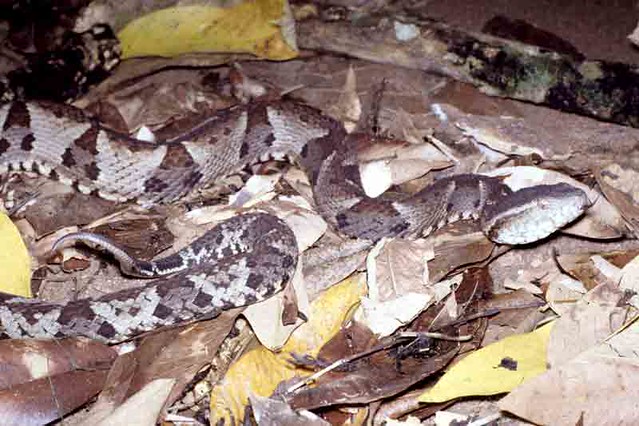Piraja's lancehead
(Bothrops pirajai)

Description
Bothrops pirajai is a species of venomous snake, a pit viper in the subfamily Crotalinae of the family Viperidae. The species is endemic to Brazil. There are no subspecies that are recognized as being valid. The maximum total length (including tail) recorded for B. pirajai is 137 cm (54 in). It is stocky and terrestrial. The specific name, pirajai, is in honor of Brazilian parasitologist Pirajá da Silva, who in 1923 was director of the Bahia branch of the Instituto Butantan. The species B. pirajai is classified as endangered on the IUCN Red List for the following criteria: A1c (v2.3, 1994). This means that it is facing a high risk of extinction in the wild in the medium-term future due to population reduction in the form of an observed, estimated, inferred or suspected reduction of at least 20% over the last 10 years or three generations, whichever is the longer, based on a decline in area of occupancy, extent of occurrence and/or quality of habitat. The rainforest inhabited by this species is unfortunately decreasing in area and quality, while becoming increasingly fragmented through deforestation. The areas that have been cleared are mainly being used for cocoa plantations. Bothrops is a genus of highly venomous pit vipers endemic to Central and South America. The generic name, Bothrops, is derived from the Greek words bothros, meaning "pit", and ώπς, ops, meaning "eye" or "face", together an allusion to the heat-sensitive loreal pit organs. Members of this genus are responsible for more human deaths in the Americas than any other group of venomous snakes. Currently, 45 species are recognized. These snakes range from small, never growing to more than 50–70 cm (19.5–27.5 in), to large at over 200 cm (6.6 ft) in total length. Most are characterized by having a sharp canthus rostralis and an unelevated snout. The arrangement of the scales on top of the head is extremely variable; the number of interorbital scales may be 3–14. Usually there are 7-9 supralabials and 9-11 sublabials. There are 21-29 rows of dorsal scales at midbody, 139-240 ventral scales, and 30-86 subcaudals, which are generally divided. Lacépède originally applied the name "lanceheads" to all of these snakes, which he considered conspecific. Thus, older writings, as well as popular and sometimes scientific writings (including the American Heritage, Merriam-Webster, and New Shorter Oxford dictionaries), still often call them fer-de-lance (French, "spearhead").
Taxonomic tree:







